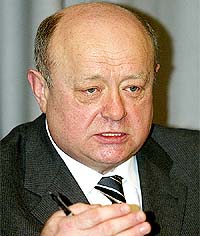
RUSSIA’S IRKUTSK REGION SEEKS SUSTAINABLE DEVELOPMENT
Publication: Eurasia Daily Monitor Volume: 4 Issue: 95
By:

Despite its abundant natural resources, the Irkutsk region of Siberia has struggled to capitalize on its significant economic potential, mainly because it has been hampered by inadequate investment, Prime Minister Mikhail Fradkov told a cabinet meeting on May 10. He also pointed out that average incomes remained low, causing people to leave the region (Interfax, RIA-Novosti, May 10).
The Irkutsk region is the starting point for the East Siberia-Pacific oil pipeline that would run from Taishet to Nakhodka. The region has the giant Kovytka natural gas field, 400 kilometers north of Irkutsk near Lake Baikal, as well as a major Sukhoi Log gold deposit. Effective January 1, 2008, Irkutsk region is due to merge with the Ust-Ordyn Buryat autonomous region.
Regional governor Alexander Tishanin told the cabinet meeting that the local authorities seek to make the region more competitive. He highlighted plans to merge the regional capital, Irkutsk, with the towns of Angarsk and Shelekhov to create a major Siberian urban center. Tishanin also sought funding from Moscow to improve the efficiency of the Baikal-Amur Railway (BAM), build a new airport in Irkutsk, and develop defense industry in the region (Interfax, May 10).
The government voiced concerns that Irkutsk development problems could have some direct security repercussions. First deputy Prime Minister Sergei Ivanov said that the region’s defense industry, notably the aircraft producer Irkut, could be hit hard by the population outflow. “In three or four years, there could be problems, notably a shortage of qualified human resources,” he said. The production of modern jets, such as the Sukhoi Su-30MKI, requires highly qualified personnel, Ivanov told the meeting.
Therefore, the government pledged to improve living conditions in Irkutsk region. First Deputy Prime Minister Dmitry Medvedev told the cabinet meeting that Irkutsk region should do more to offer affordable housing. The region should build no less than one million square meters of residential housing each year, he said.
Underdeveloped infrastructure appears to remain the region’s main sticking point. First Deputy Prime Minister Ivanov noted that Irkutsk region has a huge development potential, but it was limited by poor infrastructure, notably the lack of an adequate road network. The region’s three districts and 185 townships and villages have no access to regional roads at all, and can only be accessed by helicopter, he said (Interfax, RIA-Novosti, May 10).
Irkutsk region also boasts abundant forestry resources. In 2006, the region processed some 68% of its total timber output of 21 million cubic meters. Governor Tishanin reported that the region seeks to raise its share of processed wood up to 90% of the total production this year and 100% eventually.
Russian authorities have approved measures to discourage exports of unprocessed wood. On April 1, 2008, the Russian government will introduce a 25% export tariff (at a minimum of €15 per cubic meter) on unprocessed timber, while on April 1, 2009, the export tariff will reach a prohibitive 80% (or no less than €55 per cubic meter).
Subsequently, the Russian government reiterated plans to develop the domestic timber-processing sector. Ivanov argued that the solution of the issue of timber processing should not be limited to higher export tariffs. He suggested building new paper mills and upgrading facilities built during the Soviet era (Interfax, May 10).
Although the Russian government discussed many of Irkutsk’s problems, the key issue of the Kovytka natural gas field, a potential regional cash cow, was not mentioned. Russia has long viewed the Kovytka field as one of the most promising natural gas deposits in Siberia, as it has estimated reserves of 1.5 trillion cubic meters.
In recent months, the state-run natural gas monopoly Gazprom was reportedly considering a takeover of the Kovytka field. TNK-BP, is the main shareholder in Russia Petroleum, which holds the license to operate Kovytka. Under the licensing agreement, the firm should produce 9 bcm of gas at Kovytka in 2007, but Gazprom has refused to allow gas supplies to the local market, or a pipeline to the border before 2015.
During the 1990s, Kovytka used to be a cornerstone of Russia’s plans to supply gas to the Asia-Pacific. In November 1994, Russia and China signed a memorandum of understanding to study the feasibility of installing a 3,700-kilometer pipeline between Kovytka and China’s Lianyunggang Pacific port via Mongolia. The would-be project was expected to carry 20 billion cubic meters (bcm) of gas annually, including possible underwater links to South Korea and Japan.
In February 1999, the two states agreed to prepare a feasibility study of the gas pipeline linking Kovytka with northeastern China. The estimated cost of the project was assessed at $10-12 billion, including links to Japan and South Korea. Russia and China reportedly invested about $20 million to fund the feasibility study, but the Lianyunggang-Lianyunggang project was eventually shelved.
Now Gazprom is widely expected to take over the Kovytka gas field. However, it remains to be seen whether the Russian gas giant would allow exports from Kovytka to China eventually or rather invest in new gas chemical plants to process Kovytka gas in Siberia.




